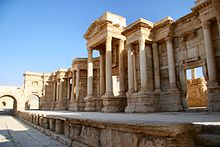Palmyra
- For places named Palmyra after this city see Palmyra (disambiguation).

Palmyra was in the ancient times an important city of central Syria, located in an oasis 215 km northeast of Damascus and 120 km southwest of the Euphrates. It has long been a vital caravan city for travellers crossing the Syrian desert and was known as the Bride of the Desert. The Greek name for the city, Palmyra (Παλμυρα), is a translation of its original Aramaic name, Tadmor, which means 'palm tree'. Tadmor (in Arabic تدمر) is today the name of a small city next to the ruins, heavily dependent on tourism.


History
Ancient

The city was first mentioned in the archives of Mari in the 2nd millennium BC. It was another trading city in the extensive trade network that linked Mesopotamia and northern Syria. Tadmor is mentioned in the Hebrew Bible (Second Book of Chronicles 8.4) as a desert city that is fortified by Solomon. The city of Tamar is mentioned in the First Book of Kings (9.18), also fortified by Solomon. This is traditionally read (see Qere) as Tadmor, but may refer to place near the Dead Sea.
Tadmor is the name of Palmyra in modern Hebrew. The exact etymology of the name "Palmyra" in this case is unknown, although some scholars believe it was related to the palm trees in the area. Others, however, are less certain, and believe it may have come out of an incorrect translation of the name "Tadmor." c.f. Colledge, Seyrig, Starcky, and others.
Greco-Roman


When the Seleucids took control of Syria in 323 BC, the city was left to itself and it became independent. The city flourished as a caravan halt in the 1st century BC. In 41 BC, the Romans under Mark Antony tried to occupy Palmyra but failed as the Palmyrans escaped to the other side of the Euphrates. The Palmyrans had received intelligence of the Roman approach. This proves that at that time Palmyra was still a nomadic settlement and its valuables could be removed at short notice. Palmyra was made part of the Roman province of Syria during the reign of Tiberius (14–37). It steadily grew in importance as a trade route linking Persia, India, China, and the Roman empire. In 129, Hadrian visited the city and was so enthralled by it that he proclaimed it a free city and renamed it Palmyra Hadriana.

Beginning in 212, Palmyra's trade diminished as the Sassanids occupied the mouth of the Tigris and the Euphrates. Septimius Odaenathus, a Prince of Palmyra, was appointed by Valerian as the governor of the province of Syria. After Valerian was captured and killed by the Sassanids, Odaenathus campaigned as far as Ctesiphon (near modern-day Baghdad) for revenge, invading the city twice. When Odaenathus was assassinated by his nephew Maconius, his wife Septimia Zenobia took power, ruling Palmyra on the behalf of her son, Vabalathus. Zenobia rebelled against Roman authority with the help of Cassius Dionysius Longinus and took over Bosra and lands as far to the west as Egypt. Next, she attempted to take Antioch to the north. In 272, the Roman Emperor Aurelian finally retaliated and captured her and brought her back to Rome. He paraded her in golden chains but allowed her to retire to a villa in Tibur, where she took an active part in society for years. This rebellion greatly disturbed Rome, and so Palmyra was forced by the empire to become a military base for the Roman legions. Diocletian expanded it to harbor even more legions and walled it in to try and save it from the Sassanid threat. The Byzantine period only resulted in the building of a few churches and much of the city was in ruin.
Islamic
The city was taken by the Muslim Arabs under Khalid ibn Walid. In the 16th century, the intimidating Fakhredin al Maany castle was built on top of a mountain overlooking the oasis. The castle was surrounded by a moat, with access only available through a drawbridge.
Further excavations
Archaeological teams from various countries have been working on-and-off on different parts of the site. In May 2005, a Polish team excavating at the Lat temple discovered a highly-detailed stone statue of the winged goddess of victory Nike.
See also
External links
Information
Photography
- A collection of pictures made in 2003 about Palmyra
- A Palmyra gallery dated spring 2005
